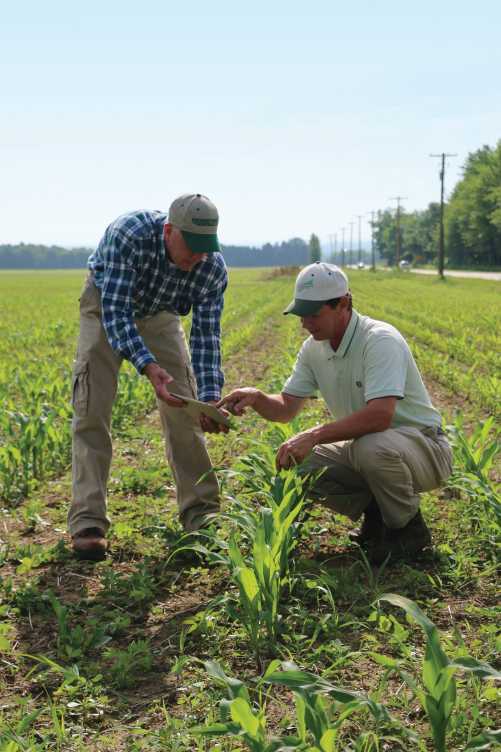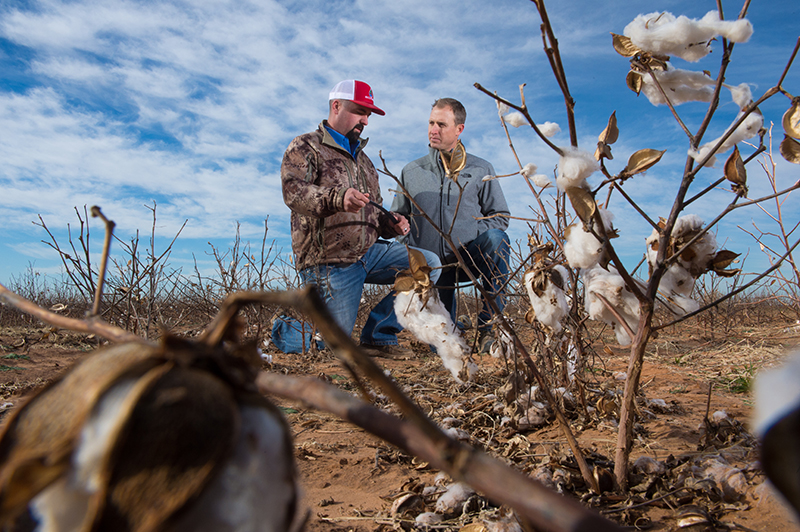Scouting, Soil Checks Gaining Value

Staying on top of a scouting routine can be challenging for many growers.
Monitoring fields for pests and soil fertility has become more essential not only for growers’ profits but also for a watching world of consumers and regulators. That’s the conclusion of a number of dealers and extension experts that CropLife® magazine spoke with this month. But the investment of resources can be substantial.
“We’ve spoiled growers,” admits one Indiana CropLife 100 retailer. Indeed, his team does “an awful lot” of scouting — so growers don’t do much of their own. His company offers three visits in a program package, two of which are done early in the season when problems can still be addressed. In addition, scouts walk fields before sprayers do any kind of post application.
He does sound a bit frustrated. “Absolutely, growers should be doing more on their own. We shouldn’t be calling them and saying, ‘Hey, guess what I found?’” he believes.
Admittedly, farm schedules are tight. Andy Heacock, crop specialist with Legacy Farmers Cooperative, McComb, OH, says many of his growers have day jobs and other time restraints that make it hard to stay on top of routine scouting. But the practice is “very important” to them, and they hire Legacy to stay in front of problems that are bound to come each year.
At Cooperative Elevator Co., Sebewaing, MI, scouting is “extremely important” to both the company and its grower customers. One scouting scenario: knowing what stage a crop is at before spraying to avoid crop injury and to maximize effectiveness, says David Holzwart, advanced agronomy manager. His team not only tracks insects and diseases in specific fields, but watches for outbreaks in neighboring acres that may pose a threat.
“Minimizing unnecessary applications of pesticides is vital for our growers to utilize resources economically and sustainably,” he says.
Lance Ruppert, agronomy marketing and implementation manager with GROWMARK, Bloomington, IL, also tells growers that identifying issues in their fields is critical to maximizing every acre. Scouting is a key ingredient to a well-rounded agronomic service and plan, he believes, adding that it helps crop specialists showcase their agronomic expertise while providing service and recommendations to growers.
In fact, GROWMARK has worked with DTN to develop DTN Scout, an iPad app that creates robust scouting reports on the fly with issue details, pin-by-pin tracking and visual references that can be shared via email or Dropbox. Its functionality and ease of use have been very well received by company scouts. The app is one of a host of in-field software products developed in just the past few years to log findings.
Cooperative Elevator’s Holzwart now sends scouting crews out with relatively inexpensive large-screened tablets that are easier to use than previous units. They also use the tablets to take photos of fields, marking the exact location with software. “We can send less-experienced members of our team into the field, still allowing the agronomist to get an accurate view of the field without him having to be there,” he says.
At Legacy Farmers Coop, crop specialists have been using electronic scouting forms which allow them to communicate very quickly with growers about what they see in the fields. Cameras on their phones has also been a convenient tool.
Delving Into Soil
Tracking what is going on below ground with soil nutrition and making fertility recommendations accordingly is another vital dealer service. In fact, the soil testing market is growing, says Tim Mundorf, field representative and precision ag specialist at Midwest Laboratories, Omaha, NE. Specifically, the increased adoption of precision ag technology and the ability to apply fertilizers at variable rates across fields has led to an increase in the density of soil sampling.
The staff at Midwest Labs had been concerned that with lower commodity prices, growers would cut back on spatially intense sampling — and just go back to composite sampling. They needn’t have worried.
“It seems that growers who have adopted grid or zone based sampling have seen the benefit of managing soil fertility at a more intense level than just by field,” says Mundorf. Simply, there’s yield benefit to be gained by finding those low fertility areas and correcting them. The integration of yield data with soil data to better match crop removal rates of fertilizer to the actual removal in specific areas is growing each year.
Should growers be doing more soil sampling? GROWMARK’s Ruppert says more knowledge means better informed decisions — but soil information will also become more valuable in coming years because documentation of applications and practices will become more important with consumers expecting transparency from farmers.
Ruppert says one of GROWMARK’s main focuses of late has been on nutrient utilization, specifically nitrogen. He is convinced that the better dealers understand how the soil interacts with fertilizer and the environment, the better they can help manage valuable resources for growers.
Soil health testing is a part of this still-expanding science. Midwest Laboratories offers two new services in this area. The Solvita Biological Respiration and Nitrification test looks at biological respiration in the soil. It assigns the amount taken a place number and uses it as a predictor of biological health and gives an estimated nitrogen mineralization amount for the season.
The Haney soil health test uses a new soil extract solution to look at nutrients that are available to a crop’s root system. It also identifies water soluble nutrients and the organic carbon and nitrogen in the soil.
“These tests don’t have as much correlation and calibration data behind them as our standard soil tests, but they give us another way to analyze our soils and maybe understand some issues that we are unable to explain with our standard soil tests,” says Mundorf. This emerging area will become more valuable as experts better understand how these tests relate to yield and overall soil health and fertility, he adds.
Tissue sampling is going to become more important in the future as it gives a better idea of the crop’s actual nutrient absorption, Michigan’s Holzwart believes. “As we push for larger yields it is going to be essential to listen to the plant’s needs rather than just track the environment it’s growing in,” he says.
One Indiana dealer agrees tissue testing is the next big thing, but it has to be a carefully planned approach, with sampling being done more than once during the plant life cycle.
Michigan’s Holzwart has found soil compaction is an ongoing problem in his territory due to cooler weather and saturated ground. To help, growers are going to have to implement practices that reduce use of heavy equipment such as utilizing tracked grain carts instead of semis when they haul crops out of the field, he says. As a dealer, Holzwart feels his job is going to be to help them understand the importance of soil structure and how it is a long-term and vital financial decision to take care of this aspect of soil health.





